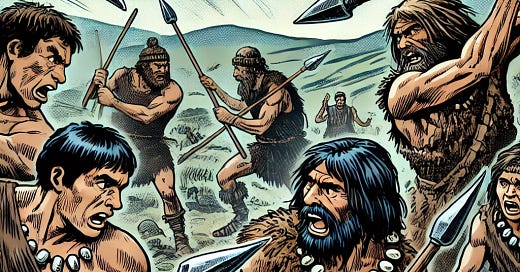I’ve written quite a bit about growing up during the 1980s. One of the key things about living through that era was the Cold War, which dominated much of American and Soviet life for the whole decade.
When I say dominated, I don’t mean that all of us kids had to do militia drills in order to prepare for a Soviet invasion after saying (or not saying) the Pledge of Allegiance every morning. Instead, I mean a state where everyone felt the threat of nuclear catastrophe, far beyond any individual’s control. We collectively whistled past the graveyard more than once.
For most of our existence, we humans have killed one another with weapons made from stone, bone, and wood. Spears and axes tipped with hard stone were all the rage, and proved to be the most effective weapons to use against one another for tens of thousands of years.
Suddenly (in big history terms), we were killing each other with weapons made from metal. To put this another way: some groups were killing other groups with weapons made from metal, while the groups still using stone started dying disproportionately.
If you were a group of people living your best life, minding your own business, and you saw that there was another group capable of killing all of your people because they had a particular weapon, it probably seemed like your duty to make sure your people got to use that weapon, too.
This wasn’t the first arms race, as early in our history as this happened. Instead, arms races have been going on in evolutionary terms for billions of years, and this is really just the most recent extension of that very long game.
The difference here is a matter of speed. While the slow, unintentional changes of biological evolution can take hundreds of thousands or even millions of years to unfold, human weapons evolution generally takes place over the span of centuries, decades, or even years.
This all describes the global arms race, as it became known during the Cold War. This arms race implies that nation-states are trying to stock up on better weapons than their enemies, racing to create new and more destructive weapons than their enemies.
The arms race itself is billed as life and death for the nations involved, so you can bet they take it very seriously, but there’s a bit of a second level arms race going on under the surface. Here, instead of spending all of one’s money on weapons, resources are instead distributed throughout various sectors of society, leading to better long term outcomes for the first level arms race.
Consider firepower for a moment. If you add up all the firepower that exists, including nukes, Russia is the leading power in the world. Clearly, just purchasing power immediately isn’t enough to win. There is much more to the game.
In a weird way, the arms race arms race is an economic struggle, first and foremost. Building up a cache of ever-more-destructive weapons makes keeping up with the Joneses a dance of life and death, but it’s cold, hard cash that produces the weapons in the first place.
There’s the obvious Sputnik moment that escalated the Cold War more than any other single event. That ultimately caused the US to quadruple down on defense spending, but it also incited us to get to the Moon. In the midst of our fears over geopolitical catastrophe, we set foot on another celestial body for the first time ever.
We also created the internet, where I always send you these little observations by way of a series of magical tubes. Why didn’t the USSR invent the internet and walk on the Moon first? Certainly, the centrally planned economic system of the Soviets (crude communism with plenty of corruption) played a big role, but the specific way it manifested was very little investment in society.
I’m talking about rock and roll, for one thing. Did rock music alone bring down the Berlin Wall? No, but you could have fooled David Hasselhoff and maybe even some East Germans on that historic day, where the taste of the culture of the west was on everyone’s lips.
It was rock music, Hollywood, and blue jeans that brought the Soviet Union down, not just the way the money was allocated. It turns out that a heavy investment in culture is actually one of the very best investments in defense you can possibly make as a nation.
It wasn’t just an arms race, but it was about securing the means to play the game long term. It was an arms race arms race.







The only kind of arms race I will find acceptable from now on is the one where contestants must use only their arms (no hands!) to propel themselves forward and win.
What a great set of connections! I was all tee-d up to weigh in and then you hit me with the Internet and Rock and Roll and David Hasselhoff. My mind is spinning. Perhaps I’ll share my David Hasselhoff treasure in Notes.
But I do have a relevant 80’s Cold War memory. I was in Berkeley listening to a speaker talk about nuclear weapons proliferation. He talked about how many nukes the US and Russia had and the destructive power of each one. Then he pulled out a bag of marbles - one for each nuke. Then he pulled out a metal bucket. He put the bucket next to the mic and started pouring the marbles into the bucket. It was loud and went on FOREVER. Then we watched Dr. Strangelove.